It looks like you're using an Ad Blocker.
Please white-list or disable AboveTopSecret.com in your ad-blocking tool.
Thank you.
Some features of ATS will be disabled while you continue to use an ad-blocker.
share:
TOPIC: The Human Brain
AIM: To give ATS a comprehensive compendium of the Human Brain including: Anatomy and functionality of the Human Brain; Historical Timeline of neurological research; PSI and the brain; 'fight or flight' phenomena; Dreamstate and the brain; disease and injury and thier effects on the Human Brain.
Team: TONE23
semperfortis
*(Springer)
biggie smalls
*= Possible contributions from Springer at a later date
[edit on 10/8/2006 by TONE23]
[edit on 15-10-2006 by ADVISOR]
AIM: To give ATS a comprehensive compendium of the Human Brain including: Anatomy and functionality of the Human Brain; Historical Timeline of neurological research; PSI and the brain; 'fight or flight' phenomena; Dreamstate and the brain; disease and injury and thier effects on the Human Brain.
Team: TONE23
semperfortis
*(Springer)
biggie smalls
*= Possible contributions from Springer at a later date
[edit on 10/8/2006 by TONE23]
[edit on 15-10-2006 by ADVISOR]
Basic Anatomy of the Human Brain:
The human brain is one of the most complex organs in the human body. It allows us to think, move, feel, hear, see, taste, smell. It receieves information, analyzes information and holds our memories. The human brain produces electrical signals, which combine with chemical reactions, allows the different parts of the body to communicate.
The human brain wieghs about 3 pounds on average. and reaches its maximum size by 6 years old. The brain consists of 40% grey matter and 60% white matter. Brain cells include neurons and glial cells.
The human brain is comprised of three main parts: the forebrain, the brainstem and the hindbrain.
Prosencephalon or "forebrain":
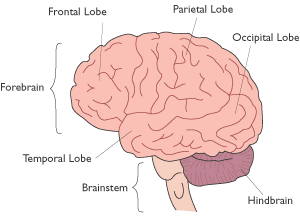
Is the most complex of the three main regions. This is the section that allows us to learn, remember and "feel". The forebrain is comprised of two parts: the telencephalon(which is comprised of cerebral cortex and corpus callosum) and the diencephalon(comprised of the thalamus and the hypothalamus)
The cerebral cortex is what allows us to process the large quantities of information we receive from all around us. The left and right portions of the cerebral cortex are seperated by a thick layer of tissue; the corpus callosum.
The thalamus allows the transfer of information to the cerebral cortex.
The hypothalamus regulates hormones, hunger, thirst, and arousal.
Other functions of the forebrain include:
Chewing
Directs sense impulses throughout the body
Equilibrium
Facial sensation
Eye movement, vision
Hearing, Phonation
Memory
Personality
Respiration
Salivation, Swallowing
Smell
Taste
The Telencephalon is comprised of the cerebral cortex, basal ganglia, corpus striatum, and olfactory bulb. It is the anterior portion of the brain, rostral to the midbrain.
The telencephalon is responsible for the following functions:
Determines intelligence
Determines personality
Interpretation of sensory impulses
Motor function
Planning and Organization
Sense of smell
Touch sensation
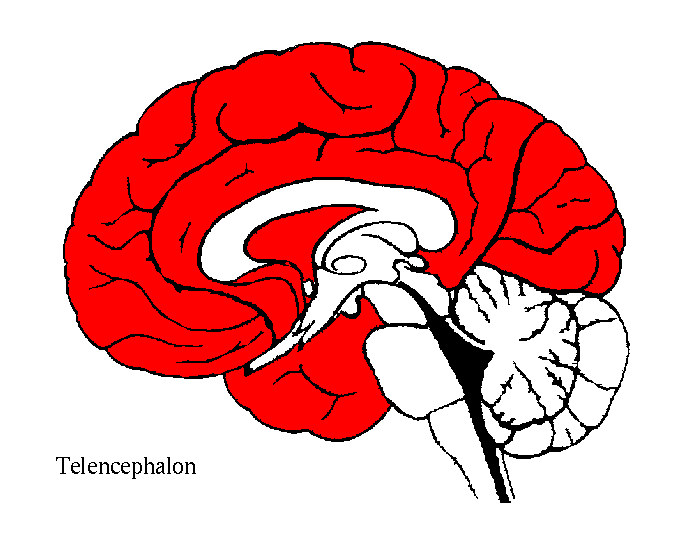
Subsections of the Telencephalon:
Cerebral Cortex: The cerebral cortex is located in the outer portion of the cerebrum. It is divided into lobes: frontal, parietal, temporal and occipital. The insula is also in this portion of the brain.
The cerebral cortex is responsible for many of the "higher order" functions like language and information processing. Below is a list of all the subsections of the cerebral cortex and their functions:
CORTICAL AREA ------ FUNCTION
Prefrontal Cortex ----- Problem Solving, Emotion, Complex Thought
Motor Association Cortex----- Coordination of complex movement
Primary Motor Cortex ----- Initiation of voluntary movement
Primary Somatosensory Cortex---- Receives tactile information from the body
Sensory Association Area ---- Processing of multisensory information
Visual Association Area----- Complex processing of visual information
Visual Cortex ----- Detection of simple visual stimuli
Wernicke's Area ----- Language comprehension
Auditory Association Area ----- Complex processing of auditory information
Auditory Cortex ----- Detection of sound quality (loudness, tone)
(Broca's Area)Speech Center ----- Speech production and articulation
The four lobes of the cerebral cortex are as follows:
Frontal lobes- the frontal lobes are located in the anterior portion of the cerebral cortex and are responsible for the following functions:
Motor functions
Higher order functions
Planning
Reasoning
Judgement
Impulse control
Memory
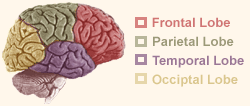
The Occipital Lobes- The occipital lobe is located at the most caudal(rear) of the cerebral cortex and is responsible for the following functions:
Controls vision
Color recognition
Parietal Lobes--The parietal lobes are anterior to the occipital lobes and posterior to the central sulcus(fissure) and frontal lobes and are responsible for the following functions:
Cognition
Information processing
Pain and touch Sensation
Spatial orientation
Speech
Visual perception
Temporal Lobes-- The Temporal lobes are anterior to the occipital lobes and lateral to the fissure of sylvius(the large deep groove or indentation that separates the parietal and temporal lobes.) It is responsible for the following functions:
Emotional responses
Hearing
Memory
Speech
Insula-- The insula is located within the cerebral cortex beneath the frontal, parietal and temporal opercula and is responsible for the following functions:
Associated with Visceral functions
Integrates Autonomic information
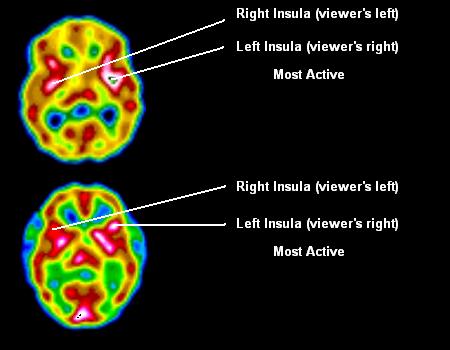
The Diencephalon is located between the cerebral hemispheres and above the midbrain. It includes the thalamus, hypothalamus, optic tracts, optic chiasma, infundibulum, Ventricle III, mammillary bodie, posterior pituitary gland and the pineal gland
The Diencephalon is responsible for the following functions:
Chewing
Directs sense impulses throughout the body
Equilibrium
Eye movement, Vision
Facial sensation
Hearing
Phonation
Respiration
Salivation, Swallowing
Smell
Taste
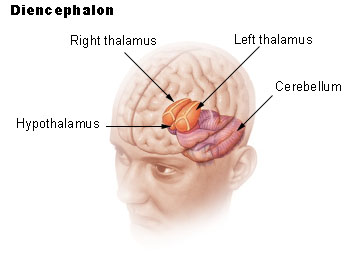
Sections of the Diencephalon and their functions are as follows:
Thalamus- The thalamus is a large, dual lobed mass of grey matter cells located at the top of the brainstem, superior to the hypothalamus. It is responsible for the following functions:
Motor control
Receives auditory, somatosensory and visual sensory signals
Relays sensory signals to the cerebral cortex
Hypothalamus-- This is located below the thalamus and posterior to the optic chiasma and is responsible for the following functions:
Controls Autonomic functions
Emotions
Endocrine functions
Homeostasis
Motor functions
Regulates food and water intake
Regulates sleep/wake cycle
Pituitary Gland-- This is located at the base of the hypothalamus and is responsible for the following functions:
Produces growth Hormone
Produces Hormones that act on the muscles and the Kidneys
Regulates Endocrine functions
Stores Hormones produced by the hypothalamus
Pineal Gland-- Is lattached to the posterior wall of the thrid ventricle and is responsible for the following functions:
Causes feeling of sleepiness
Converts Nervous System signals to Endocrine signals
Regulates Endocrine functions
Secretes the Hormone Melatonin
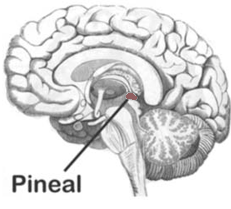
Thrid Ventricle--Is a naoorw cavity located between the two hemispheres of the Diencephalon and is responsible for the following functions:
Protects the brain from trauma
Provides pathway for the circulation of cerebrospinal fluid
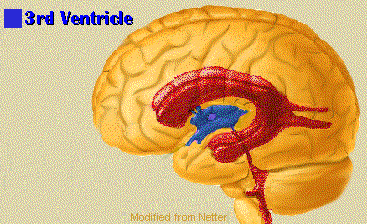
Sources: 1.) biology.about.com...
2.) www.enchantedlearning.com...
3.) images from google.com/images
[edit on 10/8/2006 by TONE23]
The human brain is one of the most complex organs in the human body. It allows us to think, move, feel, hear, see, taste, smell. It receieves information, analyzes information and holds our memories. The human brain produces electrical signals, which combine with chemical reactions, allows the different parts of the body to communicate.
The human brain wieghs about 3 pounds on average. and reaches its maximum size by 6 years old. The brain consists of 40% grey matter and 60% white matter. Brain cells include neurons and glial cells.
The human brain is comprised of three main parts: the forebrain, the brainstem and the hindbrain.
Prosencephalon or "forebrain":

Is the most complex of the three main regions. This is the section that allows us to learn, remember and "feel". The forebrain is comprised of two parts: the telencephalon(which is comprised of cerebral cortex and corpus callosum) and the diencephalon(comprised of the thalamus and the hypothalamus)
The cerebral cortex is what allows us to process the large quantities of information we receive from all around us. The left and right portions of the cerebral cortex are seperated by a thick layer of tissue; the corpus callosum.
The thalamus allows the transfer of information to the cerebral cortex.
The hypothalamus regulates hormones, hunger, thirst, and arousal.
Other functions of the forebrain include:
Chewing
Directs sense impulses throughout the body
Equilibrium
Facial sensation
Eye movement, vision
Hearing, Phonation
Memory
Personality
Respiration
Salivation, Swallowing
Smell
Taste
The Telencephalon is comprised of the cerebral cortex, basal ganglia, corpus striatum, and olfactory bulb. It is the anterior portion of the brain, rostral to the midbrain.
The telencephalon is responsible for the following functions:
Determines intelligence
Determines personality
Interpretation of sensory impulses
Motor function
Planning and Organization
Sense of smell
Touch sensation

Subsections of the Telencephalon:
Cerebral Cortex: The cerebral cortex is located in the outer portion of the cerebrum. It is divided into lobes: frontal, parietal, temporal and occipital. The insula is also in this portion of the brain.
The cerebral cortex is responsible for many of the "higher order" functions like language and information processing. Below is a list of all the subsections of the cerebral cortex and their functions:
CORTICAL AREA ------ FUNCTION
Prefrontal Cortex ----- Problem Solving, Emotion, Complex Thought
Motor Association Cortex----- Coordination of complex movement
Primary Motor Cortex ----- Initiation of voluntary movement
Primary Somatosensory Cortex---- Receives tactile information from the body
Sensory Association Area ---- Processing of multisensory information
Visual Association Area----- Complex processing of visual information
Visual Cortex ----- Detection of simple visual stimuli
Wernicke's Area ----- Language comprehension
Auditory Association Area ----- Complex processing of auditory information
Auditory Cortex ----- Detection of sound quality (loudness, tone)
(Broca's Area)Speech Center ----- Speech production and articulation
The four lobes of the cerebral cortex are as follows:
Frontal lobes- the frontal lobes are located in the anterior portion of the cerebral cortex and are responsible for the following functions:
Motor functions
Higher order functions
Planning
Reasoning
Judgement
Impulse control
Memory

The Occipital Lobes- The occipital lobe is located at the most caudal(rear) of the cerebral cortex and is responsible for the following functions:
Controls vision
Color recognition
Parietal Lobes--The parietal lobes are anterior to the occipital lobes and posterior to the central sulcus(fissure) and frontal lobes and are responsible for the following functions:
Cognition
Information processing
Pain and touch Sensation
Spatial orientation
Speech
Visual perception
Temporal Lobes-- The Temporal lobes are anterior to the occipital lobes and lateral to the fissure of sylvius(the large deep groove or indentation that separates the parietal and temporal lobes.) It is responsible for the following functions:
Emotional responses
Hearing
Memory
Speech
Insula-- The insula is located within the cerebral cortex beneath the frontal, parietal and temporal opercula and is responsible for the following functions:
Associated with Visceral functions
Integrates Autonomic information

The Diencephalon is located between the cerebral hemispheres and above the midbrain. It includes the thalamus, hypothalamus, optic tracts, optic chiasma, infundibulum, Ventricle III, mammillary bodie, posterior pituitary gland and the pineal gland
The Diencephalon is responsible for the following functions:
Chewing
Directs sense impulses throughout the body
Equilibrium
Eye movement, Vision
Facial sensation
Hearing
Phonation
Respiration
Salivation, Swallowing
Smell
Taste

Sections of the Diencephalon and their functions are as follows:
Thalamus- The thalamus is a large, dual lobed mass of grey matter cells located at the top of the brainstem, superior to the hypothalamus. It is responsible for the following functions:
Motor control
Receives auditory, somatosensory and visual sensory signals
Relays sensory signals to the cerebral cortex
Hypothalamus-- This is located below the thalamus and posterior to the optic chiasma and is responsible for the following functions:
Controls Autonomic functions
Emotions
Endocrine functions
Homeostasis
Motor functions
Regulates food and water intake
Regulates sleep/wake cycle
Pituitary Gland-- This is located at the base of the hypothalamus and is responsible for the following functions:
Produces growth Hormone
Produces Hormones that act on the muscles and the Kidneys
Regulates Endocrine functions
Stores Hormones produced by the hypothalamus
Pineal Gland-- Is lattached to the posterior wall of the thrid ventricle and is responsible for the following functions:
Causes feeling of sleepiness
Converts Nervous System signals to Endocrine signals
Regulates Endocrine functions
Secretes the Hormone Melatonin

Thrid Ventricle--Is a naoorw cavity located between the two hemispheres of the Diencephalon and is responsible for the following functions:
Protects the brain from trauma
Provides pathway for the circulation of cerebrospinal fluid

Sources: 1.) biology.about.com...
2.) www.enchantedlearning.com...
3.) images from google.com/images
[edit on 10/8/2006 by TONE23]
Basic Anatomy of the Human Brain continued
The Mesencephalon or Midbrain:
The mesencephalon is the short, constrictedportion of the brain that connects the pons and cerebellum with the thalamencephalon and cerebral hemispheres. It is directed upward and forward.
The mesencephalon is the most rostral portion of the brainstem between the forebrain and the brainstem and is responsible for the following functions:
Controls Responses to sight
Pupil dilation
Body movement
Hearing
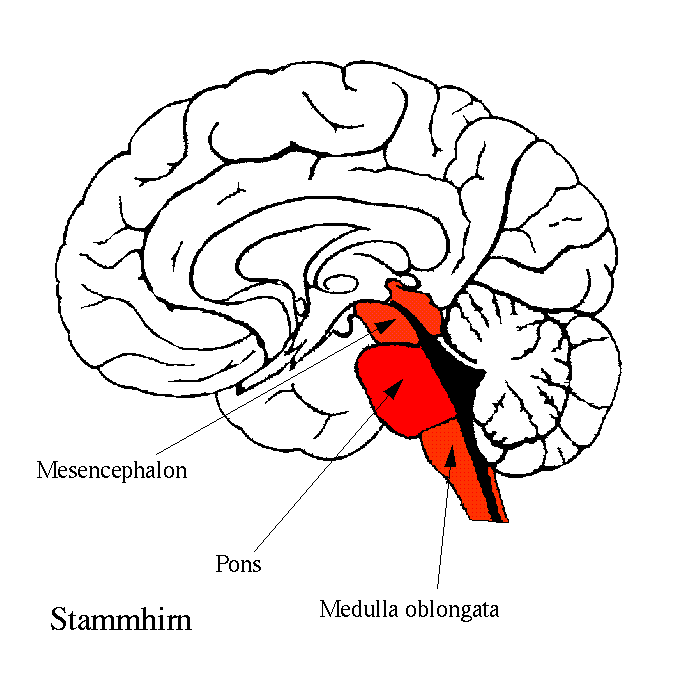
The mesencephalon consists of the tectum and the tegmentum.
Tectum-- is located in the dorsal region of the mesencephalon. It is comprised of the superior colliculi(visual receptors) and inferior colliculi(auditory receptors) and is responsible for the following functions:
Controls visual response
Tegmentum-- is located in the ventral region of the mesencephalon. It is comprised of the cerebral aqueduct, periaqueductal gray, reticular formation, substancia nigra and the red nucleus. It is responsible for the following functions:
Controls motor functions
Regulates awareness and attention
Regulates some autonomic functions
Cerebral aqueduct-- also known as the mesencephalic duct or the aqueduct of silvius. It contains cerebraospinal fluid(CSF-Cerebrospinal fluid [CSF]Liquor cerebrospinalis, is a clear bodily fluid that occupies the subarachnoid space in the brain [he space between the skull and the cerebral cortex—more specifically, between the arachnoid and pia layers of the meninges]It is basically a saline solution with microglia and acts as a "cushion" or buffer for the cortex.) is within the mesencephalon (or midbrain) and connects the third ventricle in the diencephalon) to the fourth ventricle, which is between the pons and cerebellum.
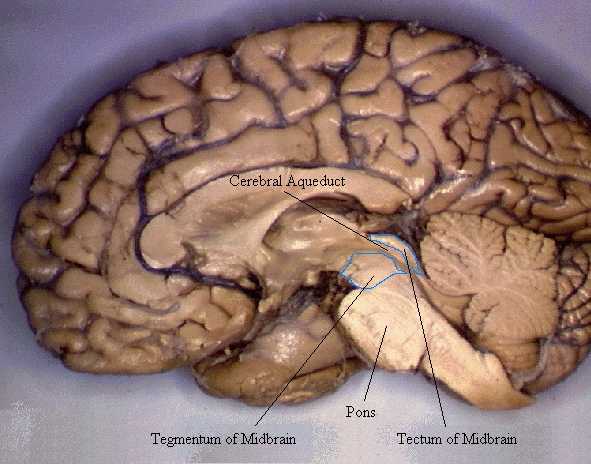
The Hindbrain or Rhombencephalon:
The Rhomecephalon is the lower portion of the brainstem and consists of three sections: The metencephalon,myelencephalonlowing, and the reticular formation and is responsible for the following functions:
Arousal
Balance
Cardiac Reflexes
Circulation
Fine Muscle Movement
Muscle Tone maintenance
Sleep
Subsections of the rhombecephalon and their functions:
The metenchephalon-- is located below the posterior portion of the cerebrum and above the medulla oblongata. It is the division of the hindbrain that consists of the pons and the cerebellum and is responsible for the following functions:
Arousal
Balance
Cardiac reflexes
Circulation
Fine muscle movement
Muscle tone maintenance
Sleep
The pons--The portion of the brainstem that is superior to the medulla oblongata and is responsible for the following functions:
Arousal
Assists in controlling autonomic functions
Relays sensory information between the cerebrum and the cerebellum
Sleep
Cerebellum--is located just above the brainstem beneath the occipital lobes at the base of the skull. It is responsible for the following functions:
Controls fine movement coordination
Muscle tone
The myelencephalon-- the most inferior portion of the brainstem and is composed of the medulla oblongata. Its functions are as follows:
Autonomic functions
Breathing
Conduction pathway for nerve tracts
Digestion
Heart rate
Swallowing
Sneezing
Medulla Oblongata--Is located inferior to the pons and anterior to the cerebellum and is responsible for the following functions:
Controls autnomic functions
Relays nerve signals between thebrain and spinal cord
The Reticular Formation-- is a group of nerve fibers located inside the brainstem and is responsible for the following fucntions:
Arousal
Attention
Cardiac reflexes
Motor functions
Regulates awareness
Relays nerve signals to the cerebral cortex
Sleep
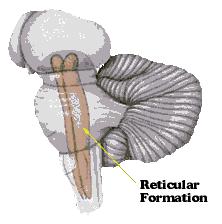
sources: 1.) biology.about.com...
2.) images from- google.com/images
[edit on 10/8/2006 by TONE23]
The Mesencephalon or Midbrain:
The mesencephalon is the short, constrictedportion of the brain that connects the pons and cerebellum with the thalamencephalon and cerebral hemispheres. It is directed upward and forward.
The mesencephalon is the most rostral portion of the brainstem between the forebrain and the brainstem and is responsible for the following functions:
Controls Responses to sight
Pupil dilation
Body movement
Hearing

The mesencephalon consists of the tectum and the tegmentum.
Tectum-- is located in the dorsal region of the mesencephalon. It is comprised of the superior colliculi(visual receptors) and inferior colliculi(auditory receptors) and is responsible for the following functions:
Controls visual response
Tegmentum-- is located in the ventral region of the mesencephalon. It is comprised of the cerebral aqueduct, periaqueductal gray, reticular formation, substancia nigra and the red nucleus. It is responsible for the following functions:
Controls motor functions
Regulates awareness and attention
Regulates some autonomic functions
Cerebral aqueduct-- also known as the mesencephalic duct or the aqueduct of silvius. It contains cerebraospinal fluid(CSF-Cerebrospinal fluid [CSF]Liquor cerebrospinalis, is a clear bodily fluid that occupies the subarachnoid space in the brain [he space between the skull and the cerebral cortex—more specifically, between the arachnoid and pia layers of the meninges]It is basically a saline solution with microglia and acts as a "cushion" or buffer for the cortex.) is within the mesencephalon (or midbrain) and connects the third ventricle in the diencephalon) to the fourth ventricle, which is between the pons and cerebellum.

The Hindbrain or Rhombencephalon:
The Rhomecephalon is the lower portion of the brainstem and consists of three sections: The metencephalon,myelencephalonlowing, and the reticular formation and is responsible for the following functions:
Arousal
Balance
Cardiac Reflexes
Circulation
Fine Muscle Movement
Muscle Tone maintenance
Sleep
Subsections of the rhombecephalon and their functions:
The metenchephalon-- is located below the posterior portion of the cerebrum and above the medulla oblongata. It is the division of the hindbrain that consists of the pons and the cerebellum and is responsible for the following functions:
Arousal
Balance
Cardiac reflexes
Circulation
Fine muscle movement
Muscle tone maintenance
Sleep
The pons--The portion of the brainstem that is superior to the medulla oblongata and is responsible for the following functions:
Arousal
Assists in controlling autonomic functions
Relays sensory information between the cerebrum and the cerebellum
Sleep
Cerebellum--is located just above the brainstem beneath the occipital lobes at the base of the skull. It is responsible for the following functions:
Controls fine movement coordination
Muscle tone
The myelencephalon-- the most inferior portion of the brainstem and is composed of the medulla oblongata. Its functions are as follows:
Autonomic functions
Breathing
Conduction pathway for nerve tracts
Digestion
Heart rate
Swallowing
Sneezing
Medulla Oblongata--Is located inferior to the pons and anterior to the cerebellum and is responsible for the following functions:
Controls autnomic functions
Relays nerve signals between thebrain and spinal cord
The Reticular Formation-- is a group of nerve fibers located inside the brainstem and is responsible for the following fucntions:
Arousal
Attention
Cardiac reflexes
Motor functions
Regulates awareness
Relays nerve signals to the cerebral cortex
Sleep

sources: 1.) biology.about.com...
2.) images from- google.com/images
[edit on 10/8/2006 by TONE23]
Anterior Commissure
The Anterior Commissure is a round bundle of nerve fibres that crosses the midline of the brain near the anterior limit of the third ventricle. It consists of a smaller anterior part, the fibres of which pass in part to the olfactory bulbs, and a larger posterior part, which interconnects the left and right temporal lobes.
Its functions are not yet clear; but it is theorized that the Anterior commisure has to do with sexual orientation.
The Anterior Commissure is used in conjunction with the Posterior Commissure to establish standard alignment for the brain. Standard alignment is achieved when the AC and the PC are in a horizontal line:
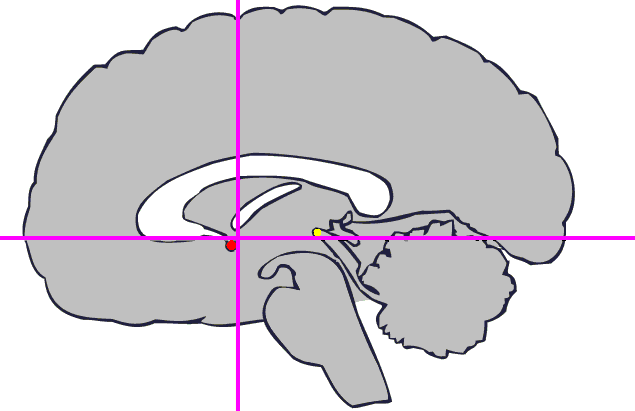
Image source:imaging.cam.ac.uk
Posterior Commissure
It is believed that the PC(posterior commissure) is essential for lid retraction of the eyes.
[edit on 10/8/2006 by TONE23]
The Anterior Commissure is a round bundle of nerve fibres that crosses the midline of the brain near the anterior limit of the third ventricle. It consists of a smaller anterior part, the fibres of which pass in part to the olfactory bulbs, and a larger posterior part, which interconnects the left and right temporal lobes.
Its functions are not yet clear; but it is theorized that the Anterior commisure has to do with sexual orientation.
The anterior commissure, a fiber tract that is larger in its midsagittal area in women than in men, was examined in 90 postmortem brains from homosexual men, heterosexual men, and heterosexual women. The midsagittal plane of the anterior commissure in homosexual men was 18% larger than in heterosexual women and 34% larger than in heterosexual men. This anatomical difference, which correlates with gender and sexual orientation, may, in part, underlie differences in cognitive function and cerebral lateralization among homosexual men, heterosexual men, and heterosexual women. Moreover, this finding of a difference in a structure not known to be related to reproductive functions supports the hypothesis that factors operating early in development differentiate sexually dimorphic structures and functions of the brain, including the anterior commissure and sexual orientation, in a global fashion.
source:pubmedcentral.nih.gov
The Anterior Commissure is used in conjunction with the Posterior Commissure to establish standard alignment for the brain. Standard alignment is achieved when the AC and the PC are in a horizontal line:

Image source:imaging.cam.ac.uk
Posterior Commissure
A thin band of white matter crossing from side to side beneath the habenula of the pineal body and over the entrance to the cerebral aqueduct and largely composed of fibers connecting mesoencephalic regions.
Source:The American Heritage® Stedman's Medical Dictionary, 2nd Edition Copyright © 2004 by Houghton Mifflin Company. Published by Houghton Mifflin Company. All rights reserved.
It is believed that the PC(posterior commissure) is essential for lid retraction of the eyes.
(4) lesions of the medial and/or principal portion of the nuclear complex of the posterior commissure are essential for the production of lid retraction. These structures are assumed to be involved in lid-eye coordination by providing inhibitory modulation of LP motor neuronal activity; (5) the ventral periaqueductal grey is assumed to play a role in the generation of tonic LP motor neuronal activity; (6) neurons of the caudal supraoculomotor area could play a role in the mediation of converging inhibitory inputs onto LP motor neurons.
source: brain.oxfordjournals.org..." target="_blank" class="postlink" rel="nofollow">brain.oxfordjournals.org
[edit on 10/8/2006 by TONE23]
Very nice, thorough and complete Tone...
I'll be starting tonight with Paranormal studies..
Semper
I'll be starting tonight with Paranormal studies..
Semper
Interview with an Interventional Radiologist.
Doctor Scott Mencken
Lots more to come folks, stay tuned..
Semper
Doctor Scott Mencken
In a typical day I am an interventional radiologist and a diagnostic one. I perform procedures either vascular, biopsy type procedures or others.
1. Is the MRI capable of revealing the effects of such aging diseases as Dementia or Alzheimer’s?
A)Yes, atrophy or volume loss with certain preferences to the frontal and temporal lobes, functional MRI is also being researched as is perfusion related imaging with either MRI, CT or PET studies.
2. The CT scanner? Or any other mechanism available?
A)See above
3. Are there significant variables to each individual’s brain?
A)Yes many but for the most part, a disease effects everyone in a similar fashion.
4. Do you use a dye for contrast?
A)Not really a dye but it is called so. We use contrast material containg iodine compound so it will show up on CT, gadolinium which is a rare earth metal that has certain magnetic sensitive properties allowing it to be detected by the MRI system. PET scan uses radioactive sugar and detects variable radiation level equivalent to areas of hypermetabolic activity-
5. Are there any known or suspected side effects of this dye, or the procedure in general?
A)Iodine has an allergic risk either mild or severe, and can be life threatening- I am allergic to this. Gadolinium for MRI has lower allergy risk. Iodine has risk to kidneys when too much is given, in diabetics or others who already have compromised renal function. Gadolinium has lower renal risks. Cannot be given to people who are pregnant or with sickle cell disease.
6. Can you explain the MRI and how it functions? Layman’s terms please.
A)To keep it simple, you place a person into a magnetic field, send in a pulse wave similar to radio with the use of gradient coils, and then use the same machine to detect the return of the signal ( which varies by proton levels in the tissue) then using an elaborate computer system to interpret the information and construct a 3 dimensional understanding that translates into an image.
7. The CT scanner?
A)Xrays are given in thin collimation beam and go through the tissues and are then received by detectors that use a computerized algorithm to reconstruct an image by 3 d volume and then make the slices based on the average density in the assigned voxels/ pixels.
8. Can you explain the difference in the two and what they are specifically used for as a comparison?
A)MRI is much better for brain, spinal cord and soft tissue imaging, it can tell if tissue is normal or cancerous. It can also tell about brain function, can use spectroscopy calculations to determine if certain tissues are cancerous, scarred, dead brain matter or normal tissue.
CT is much better for lung tissues, bones as far as for fractures or cortical erosions. CT is good for trauma evaluation such as blood in the brain, trauma to abdominal organs.
CT is also better for detecting abnormalities with the bowel such as obstrucion. looking for kidney stones and is better at looking at blood vessels compared to MRI.
Here is an example : CT is better for acute trauma, blood , skull or facial fractures. MRI is better for brain damage, swelling, or deteriming the age of hemorrhage when it is either chronic or subacute especially, we can use this information such as deteriming time of injury to a child's head from abuse.
End of Interview...
Transcribed by ATS Member Semperfortis
Lots more to come folks, stay tuned..
Semper
Paranormal Studies and the Brain :
Dr. Michael Persinger..
Research:
In short, Persinger postulates that various elemental forces present in our environment, produce reactions in the brain that are currently misunderstood. Geomagnetic forces are present in our environment at all times in varying intensity.
en.wikipedia.org...'s_magnetic_field
www.sec.noaa.gov...
This would coincide with the research as will be eluded to in the following text.
Semper
Dr. Michael Persinger..
I was born 26 June 1945 in Jacksonville Florida. I was reared primarily in Virginia, Maryland and Wisconsin. After attending Carroll College (1963-1964), I was graduated from the University of Wisconsin, Madison (1967). Psychology ("Psychochemistry") was selected as a major because it was the interface between the social and physical sciences. I obtained my M.A. (Physiological Psychology) from the University of Tennessee and my Ph.D. from the University of Manitoba (1971). I have been employed as a professor at Laurentian University in Sudbury, Ontario Canada since 1971. During this period I have published more than 200 technical articles in referred journals and have written six books (see full C.V).
~~~~~~~
My primary philosophical goal is to discern the commonalities that exist between the sciences and to integrate the fundamental concepts. I assume that the human brain, its microstructure and intricate activity are the source of all human knowledge. To that end I have emphasised geophysics because it is a central focus for the physical sciences and neuroscience (originally physiological psychology) because it is a central focus for the emerging biosocial sciences. One of the major consequences of this bilateral interest has been the pursuit and discovery of subtle interactions between the geophysical/ meteorological environment and human behavior.
Because scientific explanations and attributions are transient labels applied to the largely inferred and unseen shared sources of variance within numerical data (or verbal responses that serve as nominal data), I have pursued methodology and multivariate (statistical) approaches. Magnetic fields were selected as a focus because they are one of the few stimuli that evoke changes across all levels of scientific discourse. This perspective was summarized in ELF and VLF Electromagnetic Field Effects (1974) and Space-Time Transients and Unusual Events (1977). These approaches in conjunction with the goal of integrating concepts have influenced my decision to investigate interdisciplinary problems and to apply these skills both within academic and practical settings.
www.laurentian.ca...
Research:
Persinger (1989) points out that deep temporal lobe activity exists in equilibrium with the global geomagnetic condition. When there is a sudden decrease in geomagnetic activity, there appears to be an enhancement of processes that facilitate psi reception, especially telepathy and clairvoyance. Increases in geomagnetic activity may suppress pineal melatonin levels and contribute to reductions of cortical seizure thresholds. Indeed, melatonin is correlated with temporal lobe- related disorders such as depression and seizures. Persinger has postulated that increased geomagnetic activity may contribute to expressive psi, such as spontaneous or laboratory psychokinesis. Some research data (e.g., Braud & Dennis, 1989) support this conjecture and Gertrude R. Schmeidler (1994, p. 216) has proposed that a psychokinesis subject who is more "aroused" (by the geomagnetic activity) would be more effective.
2. Of particular relevance to psi is the capacity for the hippocampus to show long term potentiation, the first step to memory. A 400 cycles per second electrical stimulation of only 1 second can lead to semipermanent changes in electrical activity and produce observable growth of dendritic spines within 10 minutes. Such quick plasticity indicates that only a few seconds of the appropriate psi- related stimulus could evoke permanent changes in brain microstructures and hence modify memory Once the memory is consolidated it could appear as "real" as memory acquired by more traditional pathways.
3. The two temporal lobes of the brain constitute about 40% of the higher functioning area called the cerebrum; thus, there may be a greater potential for dysfunction or anomalous functioning of the temporal lobes than for other lobes. The temporal lobes are well situated for integrating perceptual stimuli of all kinds as well as for integrating various aspects of such cognitive functions as memory, learning, language, sense of self, in addition to emotional, sexual, and aggressive functions. Because of these capacities, psi experiences could also be integrated in the temporal lobes (Neppe, 1990).
www.goertzel.org...
In short, Persinger postulates that various elemental forces present in our environment, produce reactions in the brain that are currently misunderstood. Geomagnetic forces are present in our environment at all times in varying intensity.
en.wikipedia.org...'s_magnetic_field
www.sec.noaa.gov...
This would coincide with the research as will be eluded to in the following text.
Semper
A brief introduction to the type of research and the scientific acceptance of this research.
Semper
In contrast to the temporal lobes, there is little evidence or logic for claiming that an important role is played by other cerebral cortex areas. However, the frontal lobes, as the executive of the cognitive- motor cortex, could logically be associated with psychokinesis. The occipital lobes are likely candidates for apparitions, "visions," and perceptions of so- called "auras" because of their involvement in visual associations. The parietal lobes are involved in visual- spatial distortions such as those that characterize some reports of presumptive psi (Neppe, 1983). As a result of an analysis of members of two families with temporal lobe dysfunction whose members reported psi- like experiences, Neppe suggested that there may be familial predispositions to presumptive psi phenomena (Hurst & Neppe, 1981).
7. "Postmodern" Science and Psi Research
Parapsychology has pioneered research into several aspects of human behavior and experience that are now a part of mainstream psychology, e.g., hypnosis, multiple personalities, anomalous healing. Other topics investigated by the early societies for psychical research (e.g., lucid dreaming, near- death experiences, out- of- body experiences) are beginning to enter the psychological mainstream and the mechanisms for these phenomena are on their way to becoming understood. Perhaps telepathy, clairvoyance, precognition, and psychokinesis someday will travel the same road. The prefix "para" does not exclude ordinary mechanisms for psi phenomena. Neher (1990) observes that "parapsychology" simply means "alongside of" the mainstream of psychology. After reviewing the two fields, Collins and Pinch (1982) conclude that "there is...nothing in psychology that definitely makes parapsychology unscientific." They also claim that "it has not been demonstrated decisively that there are any specific physical principles that conflict with parapsychology." Truzzi (198O) would consider parapsychology to be a "legitimate scientific enterprise" whether or not psi actually exists because parapsychologists employ such scientific methods as target randomization, double- blind judging, control groups, and statistical tests. For Leahy and Leahy (1983),"methodologically, parapsychology is a science; substantially,the verdict is still out."
www.goertzel.org...
Semper
Back to the Paranormal...
The levels of Dopamine tied to individuals susceptibility to Paranormal Phenomenon.
There is direct evidence as to this subject that, while not denying Persinger's research, distracts from the overall outcome of his initial findings.
I believe however, that there is a greater possibility of each factor being a contributor to the phenomena being studied.
Semper
The levels of Dopamine tied to individuals susceptibility to Paranormal Phenomenon.
Paranormal beliefs linked to brain chemistry
Whether or not you believe in the paranormal may depend entirely on your brain chemistry. People with high levels of dopamine are more likely to find significance in coincidences, and pick out meaning and patterns where there are none.
Peter Brugger, a neurologist from the University Hospital in Zurich, Switzerland, has suggested before that people who believe in the paranormal often seem to be more willing to see patterns or relationships between events where sceptics perceive nothing.
To find out what could be triggering these thoughts, Brugger persuaded 20 self-confessed believers and 20 sceptics to take part in an experiment.
Brugger and his colleagues asked the two groups to distinguish real faces from scrambled faces as the images were flashed up briefly on a screen. The volunteers then did a similar task, this time identifying real words from made-up ones.
Seeing and believing
Believers were much more likely than sceptics to see a word or face when there was not one, Brugger revealed last week at a meeting of the Federation of European Neuroscience Societies in Paris. However, sceptics were more likely to miss real faces and words when they appeared on the screen.
The researchers then gave the volunteers a drug called L-dopa, which is usually used to relieve the symptoms of Parkinson's disease by increasing levels of dopamine in the brain.
Both groups made more mistakes under the influence of the drug, but the sceptics became more likely to interpret scrambled words or faces as the real thing.
That suggests that paranormal thoughts are associated with high levels of dopamine in the brain, and the L-dopa makes sceptics less sceptical. "Dopamine seems to help people see patterns," says Brugger.
Plateau effect
However, the single dose of the drug did not seem to increase the tendency of believers to see coincidences or relationships between the words and images.
That could mean that there is a plateau effect for them, with more dopamine having relatively little effect above a certain threshold, says Peter Krummenacher, one of Brugger's colleagues.
Dopamine is an important chemical involved in the brain's reward and motivation system, and in addiction. Its role in the reward system may be to help us decide whether information is relevant or irrelevant, says Françoise Schenk from the University of Lausanne in Switzerland.
www.newscientist.com...
There is direct evidence as to this subject that, while not denying Persinger's research, distracts from the overall outcome of his initial findings.
I believe however, that there is a greater possibility of each factor being a contributor to the phenomena being studied.
Semper
A VERY Interesting Research Project.
Though inconclusive as to the target of the study, the "hits' correlating with natural geomagnetic phenomenon surely indicate more evaluation is warranted.
Semper
Abstract
Prior research has suggested that psi performance directly correlates with the earth's geomagnetic field fluctuations, high psi hit rates correlate with low geomagnetic fields and low psi hit rates correlate with high geomagnetic hit rates. The relationship of psi and geomagnetism was investigated in a pseudorandom-number generator psi task. The results showed a correlation of r, (1670) = .059, p = n.s.. The results do not support the hypothesis. However, the means of hits and planetary A-index suggests a trend of association between high geomagnetic activity and high hits, and low geomagnetic activity and low hits.
Fluctuation effects of Earth's Geomagnetic Field on a Pseudo random-Number generator Psi Response Task
www.fpc.edu...
Subjects
Forty undergraduate students from Franklin Pierce college were used as voluntary participants.
Materials
The materials used in this experiment included: a computer controlled binary pseudorandom-number generator; weekly data sheets; and the daily planetary A-index measurements, obtained from the Internet computer service's Solar Daily Geophysical Bulletin.
Procedure
Each participant was instructed that they would need to concentrate on a twenty-five digit binary number sequence and record it on a tally sheet. The participant then received a seven day data sheet to be used to tally their daily binary sequences. Once the experimenter asked if the participants had questions, each participant then went to their residence and recorded their perceived binary sequence before 8 p.m. that day. The participants continued to record their perceived binary sequences for forty-two consecutive days, with a 10 day recess in between the testing period for college vacation. On each night of the experiment, between 8p.m. and 12 a.m., the experimenter retrieved a twenty-five binary digit sequence for each individual participant from a computer controlled pseudorandom-number generator. The computer then automatically stored each sequence on to a computer disk to keep the experimenter blind to the participant's performance. At the end of each seven day period the experimenter obtained the data sheets for the past week and gave each participant a new sheet. Once the forty-two days of experimentation was completed the experimenter collected all the remaining data sheets. After the PRNG data had been compared to the participant's raw data, the experimenter proceeded to obtain the daily geomagnetic planetary A-index levels for the testing period from the Internet computer service's Solar Daily Geophysical Bulletin. The analysis of the PAI data was purposely conducted after all of the PRNG had been analyzed to avoid experimenter bias.
Results
A Pearson product-moment correlation test revealed that there was no significant correlation between participant hits and geomagnetic activity, r, (1670) = .059, p = n.s. Figure one shows the Univariate distribution of the participant hits and daily PAI measurements.
The means of the PAI measurement and the participant hit data show a trend of association between high geomagnetic activity and high hits to be associated, and low geomagnetic activity and low hits. The mean of the PAI measurement hit data was 28.692. The theoretical mean of the participant hit data was 12.794, with a standard error of .079 and a standard deviation of 3.15. Figure two shows the combined it count all participants over the course of the experiment. Figure three shows the count of the PAI data over the courses of the experiment.
Discussion
The results are inconsistent with the hypothesis, that higher hit rates will correlate with low geomagnetic activity, and low hit rates will correlate with high geomagnetic activity. The present study gave evidence that there was no correlation in high hit rates with high geomagnetic activity, and lower hit rates with low geomagnetic activity. However, the results show a trend for higher psi hits to be possibly associated with high geomagnetic activity, and low psi hits to be possibly associated with low geomagnetic activity.
Therefore, in looking at the results of the present study it is suggested that further research be conducted with random participant pools and varied length of testing periods to created new conditions, thus we many find that there may yet be some other undiscovered variable affecting how psi tasks are induced and affected.
www.fpc.edu...
Though inconclusive as to the target of the study, the "hits' correlating with natural geomagnetic phenomenon surely indicate more evaluation is warranted.
Semper
Amygdala
The Amygdala is an almond shaped group of subcortical nuclei that are important for deconding emotions. The amygdala is large and just beneath the surface of the front, medial part of the temporal lobe where it causes the bulge on the surface called the uncus.

*source: google.com/images
The amygdala recieves its input from many other sources to form our emotions. The hypocampus, prefrontal cortex, sensory cortex, thalamus, hypothalamus, septum, brainstem all contribute their information to be processed into emotion by the amygdala.

source: thebrain.mcgill.ca
So... there it is the emotion center of the brain; the amygdala.
The Amygdala is an almond shaped group of subcortical nuclei that are important for deconding emotions. The amygdala is large and just beneath the surface of the front, medial part of the temporal lobe where it causes the bulge on the surface called the uncus.

*source: google.com/images
The amygdala recieves its input from many other sources to form our emotions. The hypocampus, prefrontal cortex, sensory cortex, thalamus, hypothalamus, septum, brainstem all contribute their information to be processed into emotion by the amygdala.

source: thebrain.mcgill.ca
So... there it is the emotion center of the brain; the amygdala.
Hey TONE23, would there be room for me on this research project? I participated in the Psychokinetic Research with SteveR and have been practising
Reiki healing treatment for quite some time now. Perhaps I could research brain interaction with healing methods? Send me a U2U please, thanks.
Epileptics and subjective paranormal experiences.
Several studies have indicated increased susceptibility to Paranormal Experiences in patients experiencing Temporal lobe dysfunction; a type of identified Epilepsy.
Again we come back to the studies of Doctor Persinger. in studies conducted in 1990, 1993 and 2003, Persinger discovered Epileptics scoring higher in tests involving EEG alpha activity in the temporal lobe. This is one indicator previously identified by Persinger as pertinent to Paranormal Experiences.
He also discovered increases in patients suffering from a variety of other maladies including, posttraumatic stress disorder, anxiety depersonalization, and "exotic dissociation", although these subjects did not reach the level of the Epileptic subjects.
There was some controversy between Persinger and a Doctor Neppe as to the validity of the determined outcome of the research even though Neppe was one of the original researchers assisting Persinger.
The end results were inconclusive yet interesting in that brain damage and psychosis both appeared to increase the subjects tenability to paranormal phenomena.
More on Persinger to follow. Also a study on electromagnetism and the effect it produces in regards to Paranormal Phenomena.
Semper
Several studies have indicated increased susceptibility to Paranormal Experiences in patients experiencing Temporal lobe dysfunction; a type of identified Epilepsy.
Again we come back to the studies of Doctor Persinger. in studies conducted in 1990, 1993 and 2003, Persinger discovered Epileptics scoring higher in tests involving EEG alpha activity in the temporal lobe. This is one indicator previously identified by Persinger as pertinent to Paranormal Experiences.
He also discovered increases in patients suffering from a variety of other maladies including, posttraumatic stress disorder, anxiety depersonalization, and "exotic dissociation", although these subjects did not reach the level of the Epileptic subjects.
Persinger's temporal lobe scales have been validated in two ways. First, it was shown that epileptics score substantially higher than controls on the scales (Persinger & Makarec, 1993). Second, amount of EEG alpha activity in the temporal lobe, but not the occipital lobe, was greater among high than low scorers on Persinger's scales (Makarec & Persinger, 1990). However, the scales do not show particularly good discriminant validity as measures of temporal lobe epilepsy. Clinical groups suffering from posttraumatic stress disorder, anxiety depersonalization, and "exotic dissociation" scored quite high on the scales (although not as high as the epileptics), and the scales correlate extremely highly (.72 to .83) with the Bernstein-Putnam Dissociative Experiences Scale (Persinger & Makarec, 1993).
There was some controversy between Persinger and a Doctor Neppe as to the validity of the determined outcome of the research even though Neppe was one of the original researchers assisting Persinger.
The end results were inconclusive yet interesting in that brain damage and psychosis both appeared to increase the subjects tenability to paranormal phenomena.
More on Persinger to follow. Also a study on electromagnetism and the effect it produces in regards to Paranormal Phenomena.
Semper
Christopher C. Green, M.D., Ph.D., Fellow in Clinical Imaging and Professor in the Departments of Diagnostic Radiology and Psychiatry and Behavioral Neurosciences, Wayne State School of Medicine.
(source credit = www.pbs.org)
Questions for Brain Research.
1. It is a common perception that Humans only utilize some percentage of what the brain is capable of. Can you elaborate on that and what advancements or discoveries have been made recently and what may be anticipated in the future?
Most of the brain does not consist of neurons, but supporting cells. These "glial" cells are active, and now are believed to link the neurons, however, in a complex set of ways. These include establishment of a passive electromagnetic field in which cognition and memory can be modulated by all sorts of influences: active biochemical, long wave-length passive, and even as yet unmeasured.
2. Are you familiar with Stanley Krippner and Michael Persinger and their research into the effects of Electromagnetic Energy and how this energy creates or influences Psychic Phenomena? If so, what is your opinion on their research.
Yes, and it is fine work. It relates to the above answer, in fact.
3. Did the Brain evolve in unison with our other organs? i.e. Are there parts of the brain more evolutionarily advanced?
The brain evolved late: the neo-cortex in man and cetaceans (whales) is larger in surface area of neurons, and directly relates to cognition; some other animals have relatively larger areas of specialized paleo-cortex (or "old"brain) like the high-iron containing and magnetically sensitive orientation portion of their cerebellum.
4. Do you think that Stem Cell Research holds as much promise for recovery from damage to the brain as the proponents would have us believe?
No, it actually has greater promise than we are being told publically. It is sure and certain that such research now underway in Asia and Europe has already eclipsed that of the United States. We have lost that race permanently.
5. Can you describe in layman’s terms what causes memory loss after brain surgery, and pertinent advancements in the repair of damaged sections of the brain.
Pressure caused by increased (and temporary) water pressure, secondary to simple inflammation.
6. On an Evolutionary scale, what do you foresee in the future as far as Human Brain Function in concerned?
Increased sensitivity to gravity and RF-waves...and the orthogonal E-[DC electric] Fields and B-[magnetic] Fields.
7. During the Fight or Flight Phenomena, are any “Higher” brain functions active?
No.
Also, can the brain be trained to function at a higher level during Fight or Flight?
No.
8. There has been speculation as to the existence of a “Criminal Gene” that causes anti-social behavior by influencing brain function. Are you familiar with this and if so, do you consider it a valid hypothesis?
It is no longer a hypothesis...it is proven.
9. How far do you expect the research involving Functional MRI, to progress?
To the state where it will be possible to use fMRI as ground-truth for intentional, cultural and social, and dine-grained psychiatric predictive measures...held back only in the US by perceived ethical limitations. We are already watching people think while making decisions under stress...and can do lie-detection with 98.7 percent precision.
10. Do you think there are possible applications of Functional MRI in Paranormal research? If so, could you please elaborate?
Yes, and I am actively seeking funding for two sets of experiments; repeat of the Persinger EEG work; doing a percipient / recipient Remote - Viewing paradigm in two fMRI's across a great distance.
Dr. Green has agreed to join the "ATS TEAM" as our "Resident Expert". The idea here is to allow ATS to be involved withGENUINE, SCIENTIFIC RESEARCH performed by one of the top experts in the world that looks into the many bizarre and as yet unexplained/misunderstood phenomena we discuss here at AboveTopSecret.com.
This is GREAT NEWS and more will be announced, I felt this thread warranted "the scoop" due to it's extremely interesting subject and outstanding contributions by our Members and their experts.
Springer...
[edit on 10-12-2006 by Springer]
Springer,
I'm speechless!!!
WOW
What an Honor... Thank you for this opportunity to associate with such an outstanding intellect and research professional.
Semper
I'm speechless!!!
WOW
What an Honor... Thank you for this opportunity to associate with such an outstanding intellect and research professional.
Semper
Medulla Oblongata
Today we are focusing on the Medulla Oblongata. For me whenever I hear those words I always think back to "the Waterboy" with Adam Sandler... But thats just the comedian in me...
The Medulla Oblongata is Located in the lower most portion of the Brainstem.
It is Above the spinal cord, below the pons, and anterior to the cerebellum.
Source: wikipedia.org
The medulla oblongata is responsible for the following functions:
Autonomic functions: breathing and heartbeat.
Sneezing
Coughing
Blinking
Swallowing
Vomiting
Suck-reflex
Relays nerve messages from the brain to the spinal cord
Processing of inter-aural time differences for sound localization (olivary nuclei)
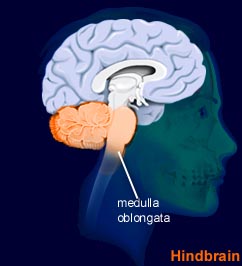
source: google.com/images
So the Medulla oblongata is like the "Grand Central Station" of the human brain in that all information is passed from the brain to the spinal cord via the medulla oblongata...pretty cool...
Today we are focusing on the Medulla Oblongata. For me whenever I hear those words I always think back to "the Waterboy" with Adam Sandler... But thats just the comedian in me...
The Medulla Oblongata is Located in the lower most portion of the Brainstem.
It is Above the spinal cord, below the pons, and anterior to the cerebellum.
Source: wikipedia.org
The medulla oblongata is responsible for the following functions:
Autonomic functions: breathing and heartbeat.
Sneezing
Coughing
Blinking
Swallowing
Vomiting
Suck-reflex
Relays nerve messages from the brain to the spinal cord
Processing of inter-aural time differences for sound localization (olivary nuclei)

source: google.com/images
Blood supply
Blood to the medulla is supplied by a number of arteries.
* Direct branches of the vertebral artery
* Posterior inferior cerebellar artery (PICA)
* Anterior spinal artery
The anterior spinal artery supplies the whole medial part of the medulla oblongata. A blockage (such as in a stroke) will injure the pyramidal tract, medial lemniscus and the hypoglossal nucleus. This causes a syndrome called medial medullary syndrome.
The posterior inferior cerebellar artery, a major branch of the vertebral artery, supplies the posterolateral part of the medulla, where the main sensory tracts run and synapse. (As the name implies, it also supplies some of the cerebellum.)
The vertebral artery supplies an area between the other two main arteries, including the nucleus solitarius and other sensory nuclei and fibres. Lateral medullary syndrome can be caused by occlusion of either the PICA or the vertebral arteries.
source: answers.com
Medulla Oblongata
The Medulla Oblongata - approx. 3 cm long - is the most inferior portion of the BrainStem and is continuous Inferiorly with the Spinal Cord. Superfically the Spinal Cord blends into the Medulla but internally there are several differences.
Discrete Nuclei (clusters of Gray Matter, composed mostly of cell bodies, surrounded by White Matter) with specific functions are found within the Medulla Oblongata but not within the Spinal Cord. In addition, the Spinal Tracts that pass through the Medulla do not have the same organization as the tracts of the Spinal Cord.
Source: biology.about.com
So the Medulla oblongata is like the "Grand Central Station" of the human brain in that all information is passed from the brain to the spinal cord via the medulla oblongata...pretty cool...
Electromagnetism and Perceived Paranormal Events..
Link 1
Link 2
The preceding article is in layman's language and the links have excellent information so I feel little elaboration will assist here.
Semper
THEORY # 2: Electromagnetic Waves Affecting the Brain
This theory was first introduced by Michael Persinger. He is the Professor of Psychology and head of the Neuroscience Research Group at Laurentian University, Ontario, Canada. His theory is that the sensation commonly described as “having a religious experience/paranormal experience” is merely a side effect of our bicameral brain’s feverish activities. Simplified considerably, the idea goes like so: When the right hemisphere of the brain, the seat of emotion, is stimulated in the cerebral region that is presumed to control notions of self; and then the left hemisphere, the seat of language, is called upon to make sense of this nonexistent entity, the mind generates a “sensed presence.” Dr. Persinger believes such cerebral “fritzing” is responsible for almost anything one might describe as paranormal, incuding aliens, heavenly apparitions, past-life sensations, near-death experiences, awareness of the soul, and so on. Experimental subjects who were exposed to a specific series of pulses from TMS (transcranial magnetic stimulation) described feeling an invisible presence near them or feeling connected to the whole world.
The experience of an "other worldly experience" is well-documented in the neuroscientific literature. It tends to happen to people who are capable of vivid imagery and who are under some sort of stress -- anything from lack of oxygen and food to a recent bereavement. Such experiences are thought to be trigge#730400 somehow in the temporal lobes, those parts of the brain around and above the ears.
Putting the Theory to the Test: M.A.T.I.S.
The VGHRS routinely conducts EM surveys of all of the property/buildings that we investigate, including initial investigations if at all possible. Typically, we ask that the electricity to the building beshut off ann wait 20-30 minutes for any residual energy to settle before the survey is conducted. We then use a Trifield meter to measure EM waves throughout the location. If an EMF spike or unusually high EM activity is recorded, we first look for natural explanations such as nearby power lines. Jim Hale gave birth to M.A.T.I.S - the Magnetic Anomaly Tracking and Identification System (read more about it here) This system presently measures infra#730400 (IR), visible (Vis), and ultraviolet (UV) light; geomagnetic (0-0.5 Hz) static electromagnetic fields; 60 Hz dynamic electromagnetic fields from wiring, vibration, and galvanic skin response of a human subject. If Dr. Persinger’s theory holds true, then one might except to find high levels of EM at a reportedly “haunted” location. The VGHRS is still collecting data to assess this theory.
Putting the Theory to the Test: The Brain Fritzer
See our techology page for more info about the Brain Fritzer
During Halloween of 2004 the VGHRS gave a presentation at the Chesterfield Historical Society's Spirit Walk at Magnolia Grange - (you can read about it here) - and had a number of people try out the Brain Fritzer. The results were exactly as we had expected - once we pulsed at least 40 hz through and around their temporal lobes people began to have the same experiences/symptoms they have before/during a paranormal experience. The VGHRS/CPRI hopes to do more research to try to pinpoint exactly how this works. Initial results look very promising.
On a side note: Dr. Persinger theorizes, for example, that just prior to earthquakes there are deformations in the natural EM field caused by the intense pressure change in subsurface tectonic plates. This might explain why some researchers have noted that when local geomagnetics conditions are ACTIVE, people often report increased levels of paranormal activity (hence, the reason for “Ghost Weather”" on our website)
The Brain Fritzer
The Brain Fritzer idea was that of Bobbie Atristain, CPRI Founder. It was modeled Dr. Michael Persinger's model of a helmet to stimulate certain regions of the brain to cause someone to have a "paranormal" experience. Tests conducted in a labortory have shown that when the temporal lobes of the human brain are stimulated with certain frequencies people will experience many of the phenomena associated with the paranormal. It is CPRI's hope that by conducting these experiments with the Brain Fritzer we can better understand how the brain and paranormal phenomena relate to one another.
M.A.T.I.S.
M.A.T.I.S. stands for Magnetic Anomaly Tracking and Identification System. It waws developed with a set of sensors that will track and identify anomalous magnetic energy in an environment. It is a computerized data recording system that can work with other kinds of sensors, including digital thermometers, IR/UV sensors, Infrasound etc.It is our hope that by tracking these anomalies in alleged "haunted" locations we can better understand its effects on the environment and hopefully help us understand the makings of paranormal phenomena.
Link 1
Link 2
The preceding article is in layman's language and the links have excellent information so I feel little elaboration will assist here.
Semper
Examining Persingers research, one may conclude that he attempts to discount any 'claims' of the Paranormal Experience.
I would however, postulate that he is simply reaching for the truth through scientific methodology. Perhaps the medium of Electromagnetism is the method of contact in dealing with subjects currently unexplainable. Perhaps the experiments and research will reveal that the brain is truly responsible for our "Mis" perceived experiences.
The only possible way to determine which, if any, of these hypothesis is correct, is to continue the research.
With breakthrough's in fMRI, PET scans and other Medically related procedures being used in research not commonly associated with traditional medicine, the future holds some answers to our many questions. Of that I am positive.
Next, more subjective information on the actual mechanics involved.
Semper
I would however, postulate that he is simply reaching for the truth through scientific methodology. Perhaps the medium of Electromagnetism is the method of contact in dealing with subjects currently unexplainable. Perhaps the experiments and research will reveal that the brain is truly responsible for our "Mis" perceived experiences.
The only possible way to determine which, if any, of these hypothesis is correct, is to continue the research.
With breakthrough's in fMRI, PET scans and other Medically related procedures being used in research not commonly associated with traditional medicine, the future holds some answers to our many questions. Of that I am positive.
Next, more subjective information on the actual mechanics involved.
Semper
Hey guys I'm new to the team. I'll be focusing on how the brain is affected by healing methods (conventional/unconventional). This will deal with
how drugs affect the brain's working as well as other things...I'm not really sure what my focus will be besides reiki and the more paranormal side
of the brain...
new topics
-
New Disney Star Wars Films Failing Test of Time?
Movies: 9 hours ago
top topics
-
Mass UAP events. DC. Machester Airport, UFOs over sub base in CT, Nuke bases.
Aliens and UFOs: 16 hours ago, 15 flags -
population madness
New World Order: 15 hours ago, 5 flags -
New Disney Star Wars Films Failing Test of Time?
Movies: 9 hours ago, 3 flags -
The Cost of True Discipleship—Count the Cost
Religion, Faith, And Theology: 14 hours ago, 1 flags
active topics
-
Results of the use of the Oreshnik missile system in Dnepropetrovsk
World War Three • 261 • : BedevereTheWise -
Trump Presidential Transition Team will not use GSA or Government entities to come to DC
US Political Madness • 21 • : matafuchs -
The Party of Peace - Trump Cabinet Picks Targeted with Death Threats
US Political Madness • 48 • : matafuchs -
New Disney Star Wars Films Failing Test of Time?
Movies • 14 • : putnam6 -
-@TH3WH17ERABB17- -Q- ---TIME TO SHOW THE WORLD--- -Part- --44--
Dissecting Disinformation • 3414 • : CarlLaFong -
population madness
New World Order • 20 • : AlroyFarms -
V.P. Kamala Harris releases a video and nobody understands why
US Political Madness • 101 • : DontTreadOnMe -
Of all things, grunge music. Short, simple, relevant, not NSFW.
Conspiracies in Religions • 48 • : Solvedit -
Mass UAP events. DC. Machester Airport, UFOs over sub base in CT, Nuke bases.
Aliens and UFOs • 23 • : CarlLaFong -
The Cost of True Discipleship—Count the Cost
Religion, Faith, And Theology • 4 • : FullHeathen

